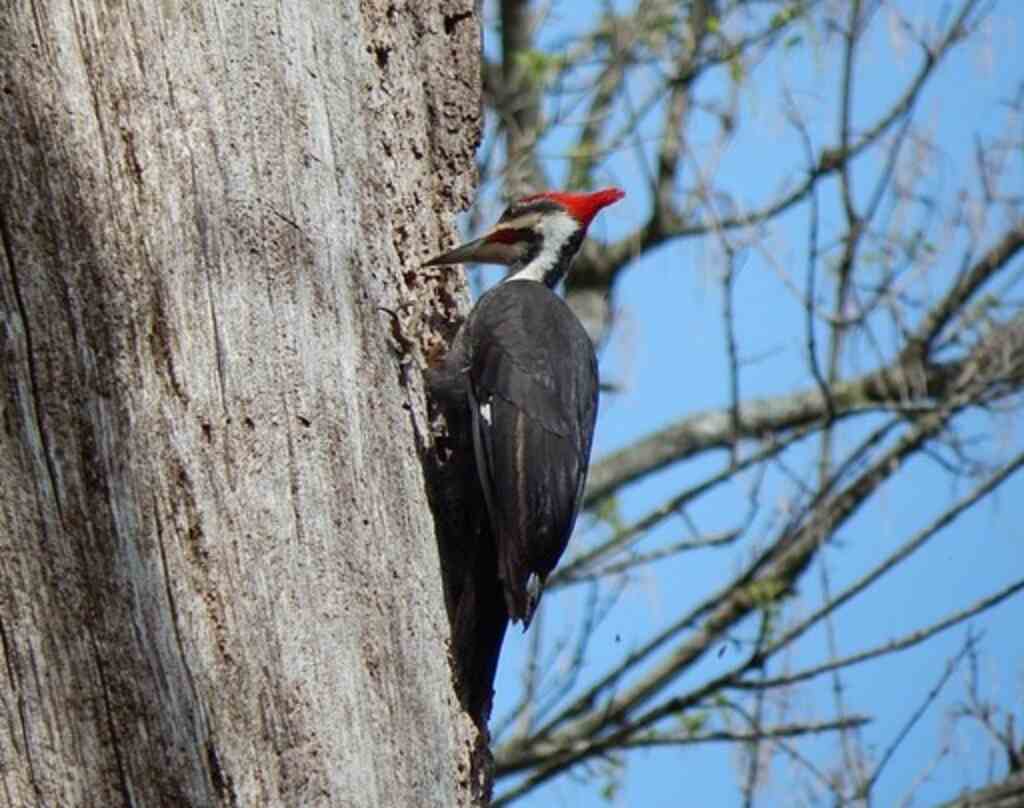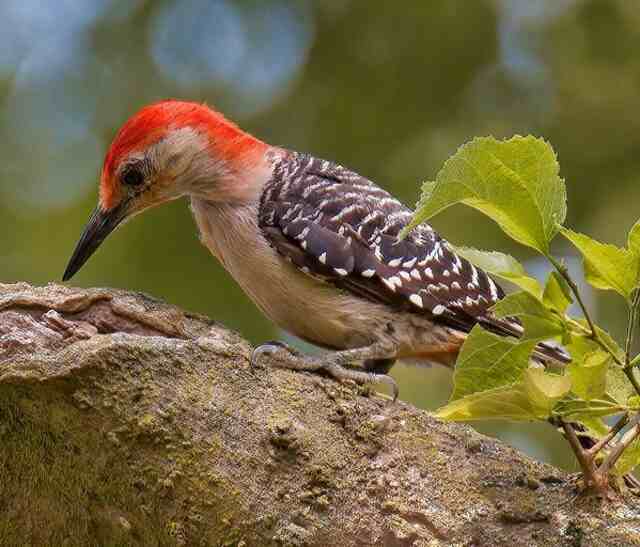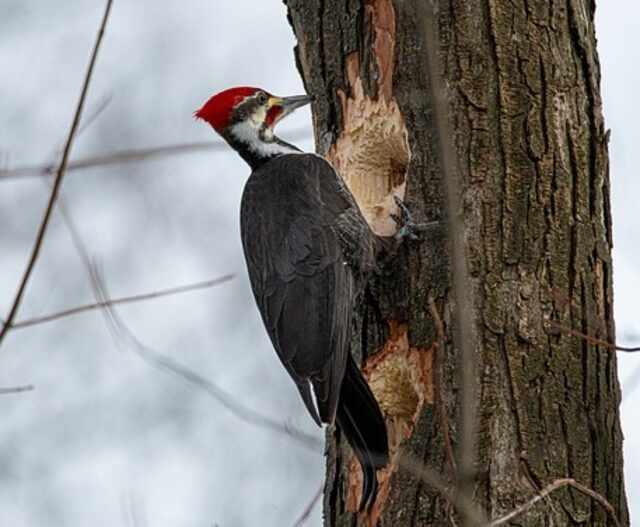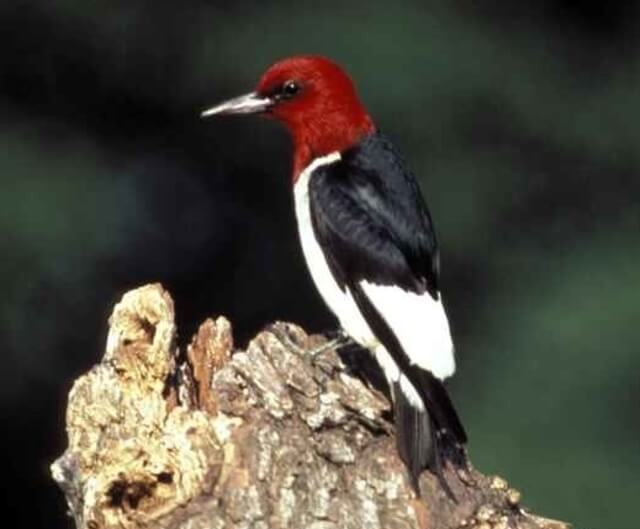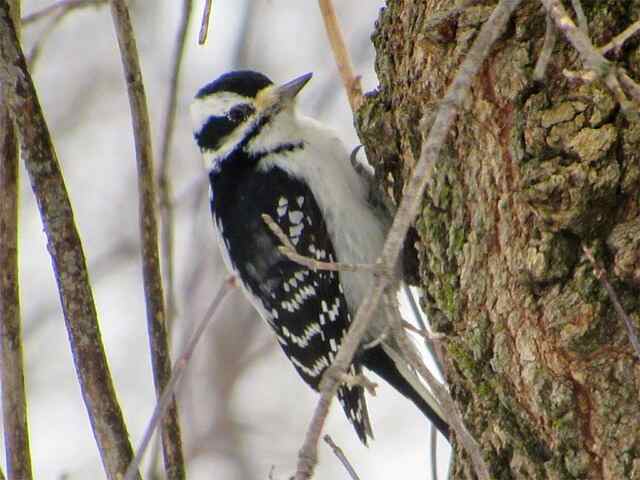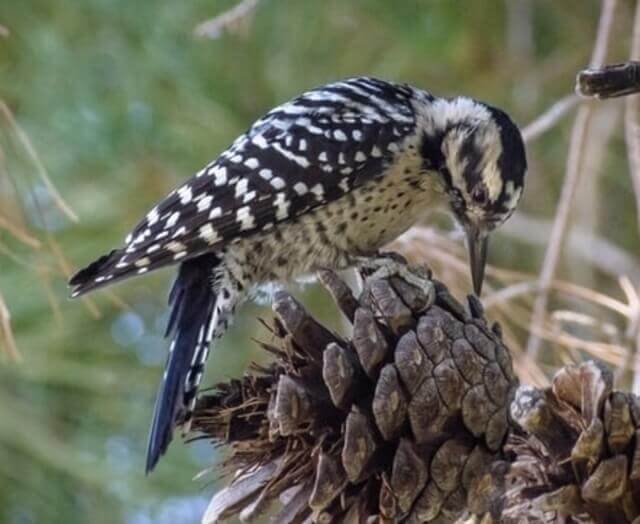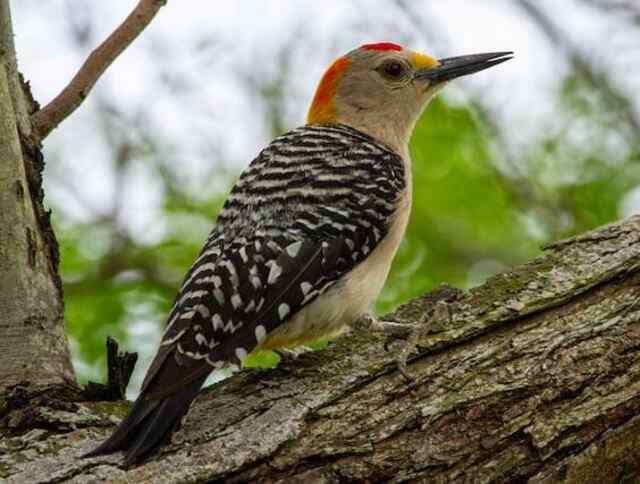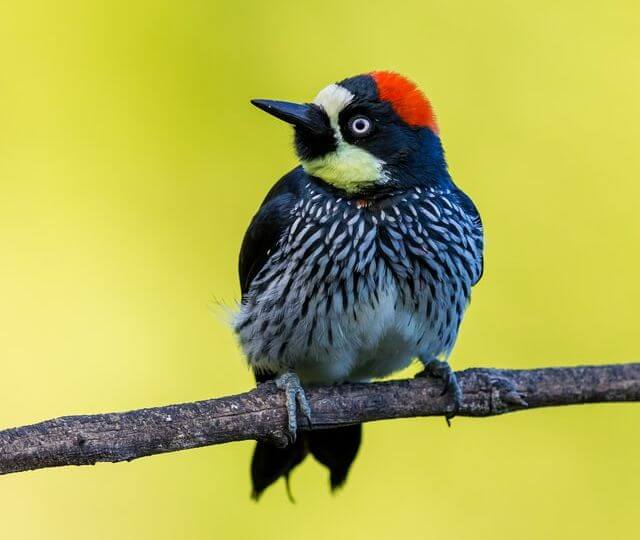Oklahoma’s diverse landscapes are a haven for bird lovers, and if you’re passionate about woodpeckers, the state offers a wealth of species to spot. From the familiar Downy Woodpecker to the majestic Pileated Woodpecker, woodpeckers in Oklahoma come in all shapes, sizes, and colors, each with its own unique charm.
Whether you’re a seasoned birder or just starting out, this ultimate guide will help you identify 10 types of woodpeckers in Oklahoma, learn about their distinctive markings and calls, and discover the best spots to observe them. Grab your binoculars and get ready to embark on an exciting birdwatching adventure through Oklahoma’s wooded wonders!
Click the Play button below to listen to our podcast:
Table of Contents
Types of Woodpeckers in Oklahoma
Red-bellied Woodpecker
- Length: 9.5 in (24 cm)
- Weight: 2.0-3.2 oz. (56-90 g)
- Wingspan: 13.0-16.5 in (33-42 cm)
- Scientific Name: Melanerpes carolinus
- Frequency of Occurrence: 24.61% (Statistic by: eBird)
- Maps: Range Map – Sightings Map
- Sounds: Calls and songs
- Where To Find Them: The Red-bellied Woodpecker is a common bird in Oklahoma. They can be found in many wooded areas, as well as urban areas. Some of the best places to spot them are in the Black Kettle National Grassland, Tallgrass Prairie Preserve, and Osage Hills Wildlife Area.
- How to Attract: There are several ways to attract this bird to your backyard. One way is to feed them suet or peanuts. Another way is to give them tree nuts or mealworms on a platform feeder. Sunflower seeds are another food source you can consider offering. I would also provide them with a bird bath, so they can bathe and drink.
Description: The Red-bellied Woodpecker is found in the eastern two-thirds of the United States, as well as in southwestern Ontario and southeastern Manitoba. This bird is also found in parts of southern Mexico. This bird is found in areas with deciduous trees and can be found in both temperate and tropical regions.
The Red-bellied Woodpecker prefers to live near water, often building its nests near bodies of water or close to the ground. The Red-bellied Woodpecker feeds mainly on insects, but will also eat small mammals, birds, and even their eggs. This woodpecker also eats a variety of fruits and seeds.
Related: How to Attract Red-bellied Woodpeckers to your Yard?
Downy Woodpecker
- Length: 5.5-6.7 in (14-17 cm)
- Weight: 0.7-1.0 oz. (21-28 g)
- Wingspan: 9.8-11.8 in (25-30 cm)
- Scientific Name: Picoides pubescens
- Frequency of Occurrence: 22.15%
- Maps: Range Map – Sightings Map
- Sounds: Calls and songs
- Where To Find Them: The foothills of the Wichita Mountains National Wildlife Refuge offer great habitat for this bird. Look for them in mixed oak and pine forests near streams and waterfalls. In the Osage Hills, you can find Downy Woodpeckers in primary and second growth forest dominated by oak, hickory, and ash trees. Look for them near small creeks and ponds. In northeastern Oklahoma, look for Downy Woodpeckers in bottomland hardwood forests near clear lakes or slow-moving rivers.
- How to Attract: The Red-bellied Woodpecker is a handsome bird and can be quite attractive to attract to your yard. One way to attract them is by providing a suet feeder with suet, or a tube feeder with peanuts, peanut butter, mealworms and black oil sunflower seeds served on a platform feeder. These foods will provide the woodpeckers with a high-energy diet that will help keep them healthy and active.
Description: The Downy Woodpecker is a common sight in most of the United States and Canada. The distribution range of the Downy Woodpecker stretches from southern Canada to California, although they are more commonly found in the north. They inhabit areas such as deciduous and mixed forests, as well as orchards.
Downy Woodpeckers are typically found in the upper levels of trees, where they extract insects from bark. They mainly eat insects such as spiders, beetle larvae, and tree sap. These are the main things that this bird consumes. However, the Downy Woodpecker will also eat other things such as berries and nuts.
Related: How to Attract Downy Woodpeckers to Your Yard? (Easy!)
Pileated Woodpecker
- Length: 15.8-19.3 in (40-49 cm)
- Weight: 8.8-12.3 oz. (250-350 g)
- Wingspan: 26.0-29.5 in (66-75 cm)
- Scientific Name: Dryocopus pileatus
- Frequency of Occurrence: 5.50%
- Maps: Range Map – Sightings Map
- Sounds: Calls and songs
- Where To Find Them: There are several places where you can see these birds in Oklahoma. One great spot is near Black Kettle National Grasslands, where you can find large groups of them feeding on tree branches.
- How To Attract: Pileated Woodpeckers are a popular bird to attract in your yard. They are attracted to suet, safflower seeds, shelled peanuts, sunflower seed and other types of bird food. Try adding these items to your bird feeder or placing them near the tree they like to perch on.
Description: The Pileated woodpecker (Dryocopus pileatus) is a large North American woodpecker. It ranges from the southern parts of Canada to central Mexico, and south to Bolivia and Ecuador. The pileated woodpecker is found in a variety of habitats, including deciduous and coniferous forests, woodland edge, suburban gardens, marshes, and riverine woodlands.
This bird is known for its powerful beak and for its habit of eating ants, wood boring beetle larvae, and termites. The pileated woodpecker feeds on insects that it finds hiding underneath tree bark or on the ground.
Related: How to Attract Pileated Woodpeckers to your Yard (Fast)
Red-headed Woodpecker
- Length: 7.5-9.1 in (19-23 cm)
- Weight: 2.0-3.2 oz. (56-91 g)
- Wingspan: 16.5 in (42 cm)
- Scientific Name: Melanerpes erythrocephalus
- Frequency of Occurrence: 5.49%
- Maps: Range Map – Sightings Map
- Sounds: Calls and songs
- Where To Find Them: The Red-headed Woodpecker is a common sight in Oklahoma. They can be found in many areas, but the key places to spot them are Wichita Mountains Wildlife Refuge and Cache Creek is a creek in Ouachita Mountains.
- How to Attract: There are few things as rewarding as watching a red-headed woodpecker work it’s way around your tree. If you want to attract this clever bird to your yard, try providing them with suet, safflower seeds, shelled peanuts, and sunflower seed.
Description: The red-headed woodpecker is found in a very large area of the United States. It ranges from the Great Lakes region down through the southern states, into parts of central and northern Mexico, and even into Argentina. In some areas, such as Florida, it is found only in small pockets. Overall, this species can be found anywhere there are trees to climb. It is found in both coniferous and deciduous forests, as well as orchards, gardens, and other wooded areas. In the winter, it can be found in parks and other large open areas.
This bird is not only common but also fairly adaptable, breeding in a variety of habitats. The diet of the red-headed woodpecker ranges from insects to spiders, earthworms, fruits, nuts, seeds, and berries. They are also known to eat birds eggs and sap. These woodpeckers prefer hard materials to peck at for food, so they will often spin or climb trees in search of insects, spiders, earthworms, fruits, nuts and seeds.
Related: Interesting Red-Headed Woodpecker Facts (Explained)
Hairy Woodpecker
- Length: 7.1-10.2 in (18-26 cm)
- Weight: 1.4-3.4 oz. (40-95 g)
- Wingspan: 13.0-16.1 in (33-41 cm)
- Scientific Name: Picoides villosus
- Frequency of Occurrence: 3.66%
- Maps: Range Map – Sightings Map
- Sounds: Calls and songs
- Where To Find Them: The Hairy Woodpecker is a common bird in Oklahoma. They can be found in many areas, but some of the best spots to see them are in the Wichita Mountains National Wildlife Refuge and the Osage Hills Wildlife Area.
- How To Attract: While there are many ways to attract a hairy woodpecker to your yard, mealworms, suet and safflower seeds are the most popular. Shelled peanuts and sunflower seed can also be used as a supplementary food source for these birds.
Description: The Hairy Woodpecker is a large woodpecker that is found in the northeastern United States and southern Canada. This woodpecker has a broad range, occurring from Nova Scotia to North Carolina and south to Florida, as well as parts of Texas and Louisiana. The Hairy Woodpecker prefers deciduous forests with lots of trees and large branches.
It also inhabits mixed oak-hardwood forests, but can also be found in areas with plantations. This bird eats mainly insects, but will also consume small amounts of fruit, berries and seeds. Insects that make up the main part of the hairy woodpecker’s diet include carpenter ants, wood-boring beetles and bark beetles, and moth pupae.
Ladder-backed Woodpecker
- Length: 6.3-7.1 in (16-18 cm)
- Weight: 0.7-1.7 oz (21-48 g)
- Wingspan: 13.0 in (33 cm)
- Scientific Name: Dryobates scalaris
- Frequency of Occurrence: 0.5662%
- Maps: Range Map – Sightings Map
- Sounds: Calls and songs
- Where To Find Them: Ladder-backed Woodpecker is a very rare bird and the best places to spot them in Oklahoma are in the Wichita Mountains Wildlife Refuge, the Osage Hills Sate Park, and the Cache Creek Wildlife Area.
- How to Attract: These birds like to feed on insects and other small creatures, so providing them with food is important for attracting them to your yard. One way to attract these birds is to feed them mealworms, suet or safflower seeds, shelled peanuts, and sunflower seed.
Description: The Ladder-backed Woodpecker is a common bird in much of the eastern United States. The range of this bird extends from Nova Scotia to Texas and west to Oklahoma and north to Manitoba. In the southwestern part of its range, they can be found as far south as northern Mexico.
This woodpecker is typically found in deciduous and mixed forests, but it has been known to exist in coniferous forests, too. The Ladder-backed Woodpecker feeds on insects, mostly beetles and bark beetles, but also carpenter ants and moth pupae. It will also eat berries and seeds.
Golden-fronted Woodpecker
- Length: 8.7-10.2 in (22-26 cm)
- Weight: 2.6-3.5 oz (73-99 g)
- Wingspan: 16.5-17.3 in (42-44 cm)
- Scientific Name: Melanerpes aurifrons
- Frequency of Occurrence: 0.2292%
- Maps: Range Map – Sightings Map
- Sounds: Calls and songs
- Where To Find Them: The golden-fronted woodpecker is a very rare bird in Oklahoma. It can be found in the Wichita Mountains and in the Ouachita Mountains, but it is most commonly seen in the Cherokee Landing State Park. The best places to spot these birds are in areas with lots of trees and good foraging areas.
- How to Attract: These birds like to eat insects, so you may want to try attracting them with things like mealworms, suet, safflower seeds, shelled peanuts, and sunflower seed.
Description: The Golden-fronted Woodpecker is a common bird in North America. They are found in most of the United States, as well as parts of Canada and Mexico. In the east, they occur as far south as Panama. This woodpecker is a common sight in the forests of North America. It’s preferred habitats include mixed deciduous and coniferous forests, but they are also found in woodlands near water.
Like many other woodpeckers, the Golden-fronted Woodpecker feeds on insects such as beetles, carpenter ants, berries, fruit and sometimes acorns and seeds. However, it is particularly fond of sap from trees, which it extracts with its long tongue.
Lewis’s Woodpecker
- Length: 10.2-11.0 in (26-28 cm)
- Weight: 3.1-4.9 oz. (88-138 g)
- Wingspan: 19.3-20.5 in (49-52 cm)
- Scientific Name: Melanerpes lewis
- Frequency of Occurrence: 0.0712%
- Maps: Range Map – Sightings Map
- Sounds: Calls and songs
- Where To Find Them: A very rare bird that can be found only in a few select areas in Oklahoma, the Lewis’s Woodpecker is an impressive sight. Best places to spot them include the Wichita Mountains National Wildlife Refuge and Cache Creek State Park.
- How to Attract: One woodpecker that is particularly fun to watch is the Lewis’s Woodpecker. If you want to attract this bird to your yard, you’ll need to provide plenty of food supplies. Woodpeckers like to eat things like mealworms, suet, safflower seeds, shelled peanuts, and sunflower seed. You can also try putting out a few pieces of fruit.
Description: The Lewis’s Woodpecker is a common and widespread bird found in most of the eastern United States. The Lewis’s Woodpecker ranges from Nova Scotia south to Florida and
west to Texas. The woodpecker is mainly found in deciduous and mixed woods, but it will also inhabit plantation forests. In the winter, the Lewis’s Woodpecker can be found in warmer climates such as Louisiana, Mississippi, and Alabama.
These birds are found in a variety of habitats, including deciduous and coniferous forests, swamps, and suburban areas. They are usually seen high in the trees or on exposed limbs. The primary food of the Lewis’s Woodpecker is wood-boring insects, but they also eat seeds, nuts, berries and fruits and grains.
Red-cockaded Woodpecker
- Length: 7.9-9.1 in (20-23 cm)
- Weight: 1.5-1.8 oz. (42-52 g)
- Wingspan: 14.2 in (36 cm)
- Scientific Name: Picoides borealis
- Frequency of Occurrence: 0.0240%
- Maps: Range Map – Sightings Map
- Sounds: Calls and songs
- Where To Find Them: The Red-cockaded Woodpecker is a very rare bird in Oklahoma. They are only found in the southeastern part of the state and can be difficult to spot. Some of the best places to spot them are in the Ouachita Mountains, near Harrah and Muskogee, and around Lake Murray. These birds are usually shy and will not stay long if they spot humans, but they are worth searching for if you get the chance.
- How to Attract: To attract the red-cockaded woodpecker to your property, you can offer them mealworms, suet, safflower seeds, shelled peanuts, and sunflower seed.
Description: The Red-cockaded Woodpecker is found throughout the southeastern United States. They can be found in Florida, Georgia, South Carolina, North Carolina, Tennessee, Kentucky, Virginia, Maryland and Pennsylvania. It is found in deciduous and mixed forests, as well as in orchards.
This woodpecker is one of the most common birds in its range, making it a valuable part of many ecosystems. The red-cockaded woodpecker predominantly eats ants, beetles, cockroaches, caterpillars, wood-boring insects, and spiders. It will also eat fruit and berries on occasion.
Acorn Woodpecker
- Length: 7.3-9.4″ in (18.5-24.0 cm)
- Weight: 2.3-3.2 oz. (65-90 g)
- Wingspan: 13.8-17.7 in (35-45 cm)
- Scientific Name: Melanerpes formicivorus
- Frequency of Occurrence: 0.0031%
- Maps: Range Map – Sightings Map
- Sounds: Calls and songs
- Where To Find Them: Acorn Woodpecker are very rare in Oklahoma, but they can be found in a few areas. One of the best places to spot them is at the Wichita Mountains Wildlife Refuge.
- How To Attract: Acorn woodpeckers are attracted to many different types of food, but some of the best foods to attract them are mealworms, suet, safflower seeds, shelled peanuts, and sunflower seed. Acorns are also a good food source for these birds.
Description: The Acorn Woodpecker is a small woodpecker that can be found in the eastern United States and parts of Canada. This bird is known for its habit of eating acorns, which it finds throughout its range. The Acorn Woodpecker is a common sight in mixed forests and woodlands, but it is also seen in more open habitats, such as fields and gardens.
The Acorn Woodpecker is the only species of woodpecker that eats acorns. They are able to crack open these hard nuts by hammering them with their beak. Acorns are an important part of the Acorn Woodpecker’s diet, making up over 75% of their food intake. It also eats insects, nuts, fruits, and seeds.
Related Post: 60 Common Backyard Birds In Oklahoma 2022 (Full Guide!)

